 |
 |
 |
| |
In vitro Effect of CCR5 Antagonists on Innate Immune System: Maraviroc Inhibits the Migration of Neutrophils, Macrophages and Dendritic Cells
|
| |
| |
I. Sauzullo1, M. Lichtner2, F. Mengoni1, R. Rossi1, A.P. Massetti1, C.M. Mastroianni*2, V.Vullo11Sapienza University of Rome and 2Sapienza Univ, Polo Pontino, Latina, Italy
C.M. Mastroianni
Dept. Infect. and Trop. Diseases
Sapienza University, Latina
Polo Pontino, Latina, Italy,
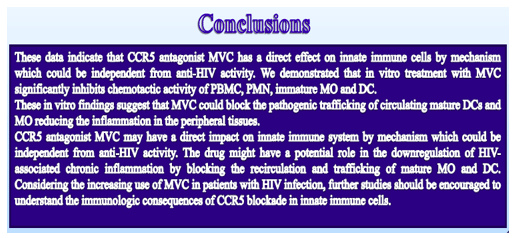
ABSTRACT
Background: Clinical studies indicate that treatment with CCR5 antagonist maraviroc (MVC) induces a greater immunologic benefit beyond that attributable to its antiviral activity. The mechanisms underlying this phenomenon are unknown and data on the in vitro direct effect of the drug on immune system are lacking. The goal was to study the in vitro direct effect of MVC on several immune cells, as PBMC, neutrophils (PMN), mature and immature dendritic cells (DC) and macrophages, by assessing apoptosis, cell viability, and cell migration.
Methods: PBMC and PMN were isolated from the buffy coat of healthy donors. Macrophage and DC were generated from adherent monocytes cultured for 6 days in the presence of granulocyte-macrophage colony stimulating factor (GM-CSF) (50 ng/mL) alone or GM-CSF with IL-4 (40 ng/mL), respectively. To induce maturation, cells were cultured with medium containing lipopolysaccharides (LPS) (0.1 mg/mL) for an additional 24 hours. The cells (2x106/mL) were pre-incubated with different concentrations of MVC. Apoptosis of both PBMC and PMNL was assessed by the activity of caspase 3 in cell lysates. The chemotactic activity of PMN, DC, and macrophages was assessed using FMLP (10-6M) as chemoattractant and measured by both microscopy and cytometry.
Results: No significant variations on apoptosis was detectable after 24 hours incubation with all MVC concentrations used for both PBMC (CNT: 0.21±0.001; MVC 200 nM: 0.20±0.01; MVC 20 μM 0.19±0.01), and PMNL (CNT: 0.18±0.09; MVC 200 nM: 0.13±0.02; MVC 20 μM 0.159±0.05). In vitro treatment with MVC induced a 70% and 80% reduction of chemotactic activity in both PMN and PBMC. In addition, MVC used at therapeutic concentration (0.1 mM) reduced chemotaxis only in mature MO and DC (mean±SD: 12±0.2 of migrated cells versus 36±7 for MO and 36±1.4 of migrated cells versus 78±10 for MDC; P <0.05). When immature cells were assessed, MVC did not affect chemotactic activity of both MO and DC within the range of therapeutically achievable concentrations in the patients. Immature MO and DC chemotaxis was inhibited only at higher concentration tested (10 mM).
Conclusions: These data indicate that the CCR5 antagonist MVC has a direct effect on innate immune cells by mechanism which could be independent from anti-HIV activity. We demonstrated that in vitro treatment with MVC significantly inhibits chemotactic activity of PMN, macrophages, and DC. These findings suggest that MVC might have a potential role in the down-regulation of HIV-associated chronic inflammation by blocking the recirculation and trafficking of macrophages and DC.
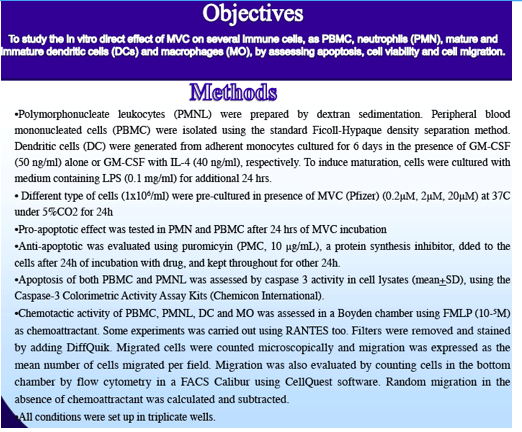
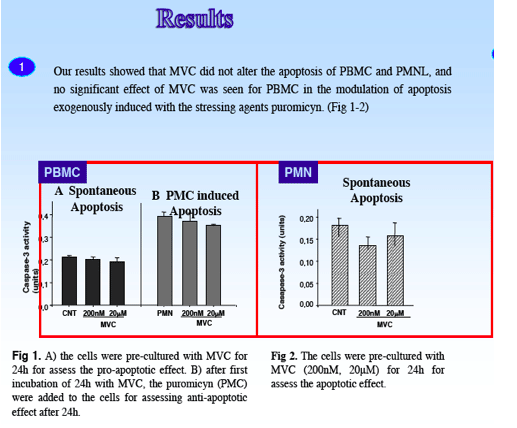
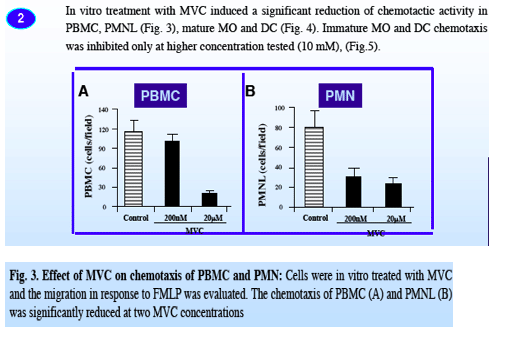
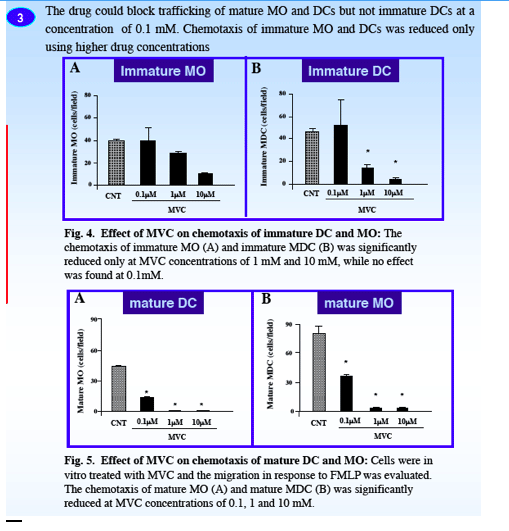
|
| |
|
 |
 |
|
|